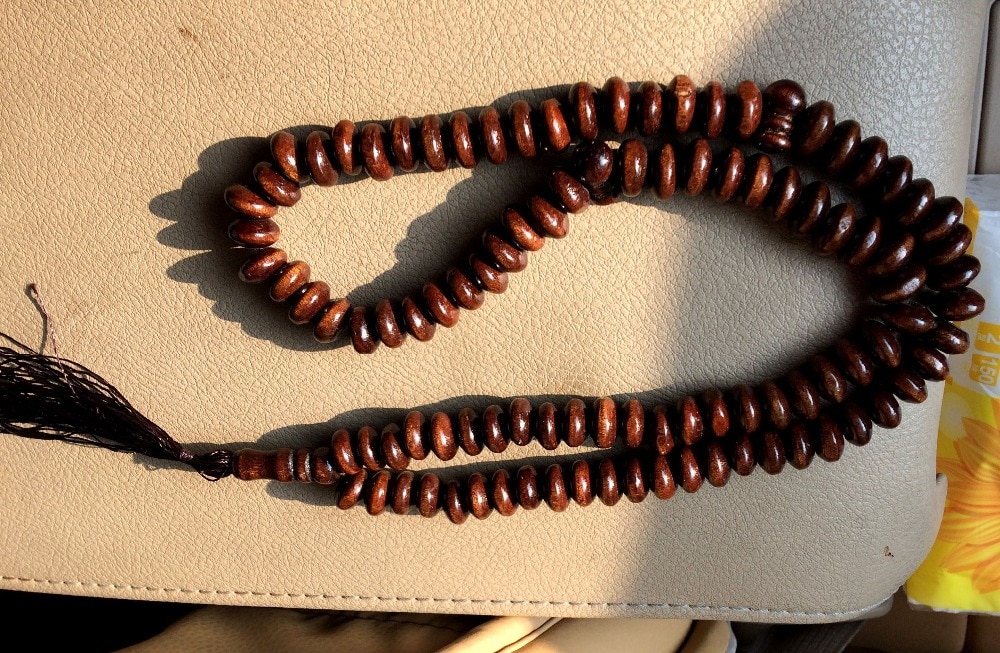Islamic prayer beads: Subha

Definition
Prayer pearls are used in many religions and cultures around the world, either to help with prayer and meditation or simply to keep your fingers busy during times of stress. Islamic prayer beads are called subha, from a word which means to glorify God (Allah).
Pronunciation: sub'-ha
Also known as: misbaha, pearls of dhikr, pearls of concern. The verb to describe the use of pearls is tasbih or tasbeeha. These verbs are also sometimes used to describe pearls themselves.
Alternative spelling: subhah
Common spelling mistakes: "Rosary" refers to the Christian / Catholic form of prayer beads. Subha are similar in design but have distinct variations.
Examples: "The old woman touched the subha (Islamic prayer beads) and recited prayers while waiting for the birth of her nephew".
History
At the time of the Prophet Muhammad, Muslims did not use prayer pearls as an instrument during personal prayer, but they may have used date wells or small pebbles. Reports indicate that Caliph Abu Bakr (that Allah is happy with him) used a subha similar to modern ones. The widespread production and use of subha began about 600 years ago.
matter
Subha pearls are often made of round glass, wood, plastic, amber or precious stone. The cable is generally made of cotton, nylon or silk. There is a wide variety of colors and styles on the market, ranging from inexpensive mass-produced prayer beads to those made with expensive materials and high-quality workmanship.
Design
Subha may vary in style or decorative embellishments, but they share some common design qualities. Subha has 33 round beads or 99 round beads separated by flat discs in three groups of 33. There is often a larger leader bead and a tassel at one end to mark the starting point of the recitations. The color of the pearls is very often uniform on a single strand, but can vary widely between sets.
Use
Subha is used by Muslims to help count recitations and concentrate on personal prayers. The worshiper touches one bead at a time while reciting the words of dhikr (remembrance of Allah). These recitations are often of the 99 "names" of Allah, or of phrases which glorify and praise Allah. These sentences are often repeated as follows:
Subhannallah (Glory to Allah) - 33 times
Alhamdilillah (Praise to Allah) - 33 times
Allahu Akbar (Allah is great) - 33 times
This form of recitation derives from a story (hadith) in which the prophet Muhammad (peace be upon him) instructed his daughter, Fatima, to remember Allah using these words. He also said that believers who recite these words after each prayer "will have forgiven all sins, even though they may be as large as foam on the surface of the sea."
Muslims can also use prayer pearls to count more recitations than other sentences during personal prayer. Some Muslims also wear pearls as a source of comfort, fingering them when they are stressed or anxious. Prayer beads are a common gift item, especially for those returning from Hajj (pilgrimage).
Improper use
Some Muslims can hang prayer beads at home or near small children, in the erroneous belief that pearls will protect against harm. Blue pearls that contain an "evil eye" symbol are used in similar superstitious ways that have no basis in Islam. Prayer beads are often worn by artists who swing them during traditional dances. These are baseless cultural practices in Islam.
Dove comprare
In the Muslim world, subha can be found for sale in stand-alone kiosks, in souks and even in shopping malls. In non-Muslim countries, they are often transported by merchants who sell other imported Islamic goods, such as clothing. Smart people can even choose to create their own!
alternative
There are Muslims who see subha as an unwanted innovation. They claim that the prophet Muhammad himself has not used them and that they are an imitation of the ancient pearls of prayer used in other religions and cultures. Alternatively, some Muslims use their fingers alone to count the recitations. Starting with the right hand, the worshiper uses his thumb to touch each joint of each finger. Three joints on one finger, on ten fingers, result in a count of 33.